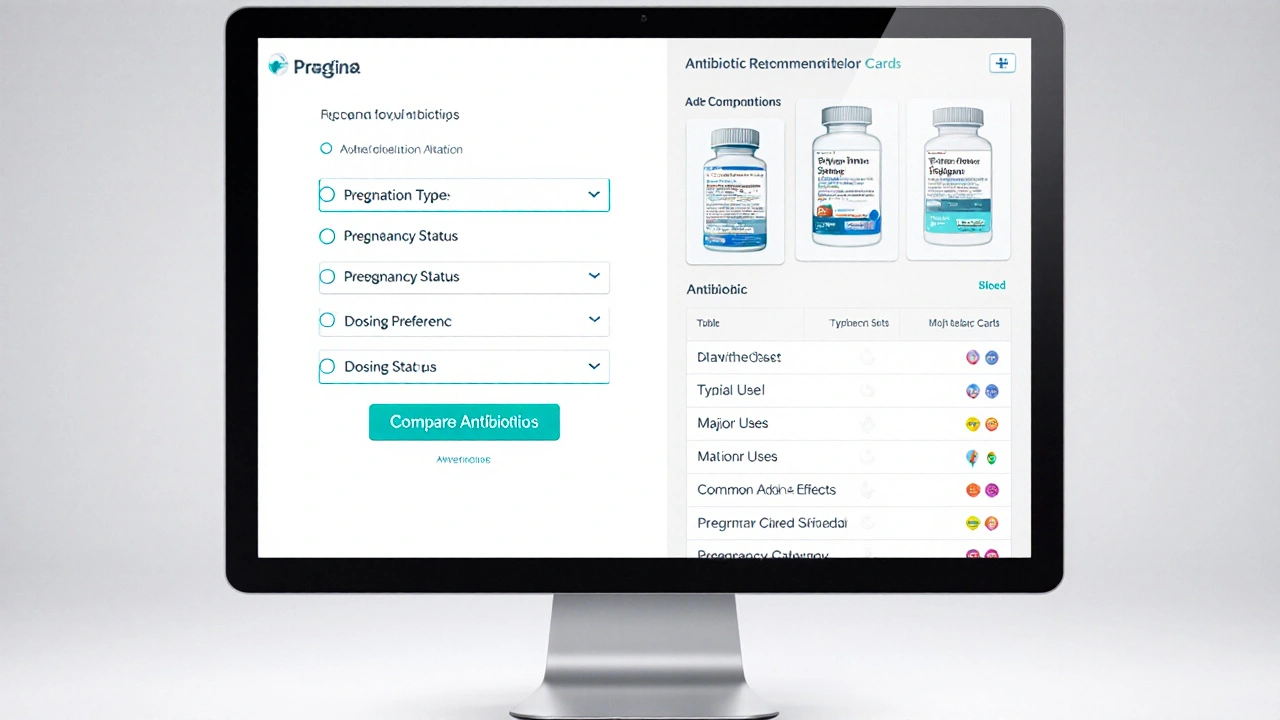Antibiotic Choice Comparison Tool
| Antibiotic | Typical Dose | Major Uses | Common Side Effects | Pregnancy Category |
|---|
Quick Take
- Doxycycline Hyclate is a broad‑spectrum tetracycline used for skin, respiratory and sexually transmitted infections.
- Key alternatives include minocycline, tetracycline, azithromycin, amoxicillin and clindamycin.
- When choosing, weigh spectrum of activity, dosing convenience, side‑effect profile and pregnancy safety.
- Minocycline offers similar coverage with fewer GI complaints, while azithromycin is a once‑daily option for atypical pathogens.
- Always confirm with a clinician; misuse can fuel resistance.
What is Doxycycline Hyclate?
Doxycycline Hyclate is the most common salt form of the tetracycline antibiotic doxycycline. It belongs to the tetracycline class, which blocks bacterial protein synthesis by binding to the 30S ribosomal subunit. Typical adult dosing ranges from 100mg once daily to 200mg split into two doses, depending on the infection.
How Doxycycline Works
The drug is bacteriostatic: it halts bacterial growth long enough for the immune system to clear the infection. Because it targets a fundamental step in protein production, it’s effective against a wide range of gram‑positive and gram‑negative bacteria, as well as atypical organisms like Chlamydia trachomatis and Rickettsia.
Common Uses and Effectiveness
Doctors prescribe doxycycline for acne, Lyme disease, respiratory tract infections, malaria prophylaxis, and several sexually transmitted infections. In clinical trials, a 7‑day course cleared uncomplicated chlamydia in over 95% of cases, and a 14‑day course reduced acne lesions by about 60%.
Key Considerations Before Starting
While doxycycline is convenient-often just one pill a day-there are a few things to watch:
- Sun sensitivity: UV exposure can cause severe photosensitivity; sunscreen and protective clothing are a must.
- Gastro‑intestinal upset: Taking the pill with food reduces nausea but may also lower absorption slightly.
- Pregnancy and breastfeeding: Classified as Category D; avoid unless the benefit clearly outweighs the risk.
- Drug interactions: Calcium, iron, magnesium, and zinc supplements can chelate doxycycline, cutting its effectiveness by up to 50%.

Alternative Antibiotics to Consider
If doxycycline isn’t suitable, several other agents provide overlapping coverage. Below is a quick snapshot of five common alternatives.
- Minocycline: Another tetracycline, often used for acne and respiratory infections. It’s more lipophilic, so it penetrates skin and tissue well and usually causes fewer stomach issues.
- Tetracycline: The older sibling of doxycycline. Requires multiple daily doses and has a higher risk of GI side‑effects but remains cheap.
- Azithromycin: A macrolide with a long half‑life, allowing once‑daily dosing for 3‑5days. Good for atypical pneumonia and chlamydia, but resistance is rising.
- Amoxicillin: A beta‑lactam useful for many streptococcal infections and otitis media. Not effective against intracellular organisms that doxycycline covers.
- Clindamycin: Targets anaerobes and skin infections; preferred when MRSA is a concern. Requires twice‑daily dosing and can cause C.difficile colitis.
Side‑Effect Profiles at a Glance
| Antibiotic | Typical Dose | Major Uses | Common Side Effects | Pregnancy Category |
|---|---|---|---|---|
| Doxycycline Hyclate | 100‑200mg once or twice daily | Acne, Lyme, STIs, malaria prophylaxis | Photosensitivity, nausea, esophagitis | D |
| Minocycline | 100mg once or twice daily | Acne, respiratory infections | Dizziness, skin discoloration | D |
| Tetracycline | 250‑500mg four times daily | Broad‑spectrum infections | GI upset, photosensitivity | D |
| Azithromycin | 500mg daily for 3‑5 days | Chlamydia, atypical pneumonia | Diarrhea, QT prolongation | B |
| Amoxicillin | 500mg three times daily | Strep throat, otitis media | Rash, mild GI upset | B |
| Clindamycin | 300‑450mg three times daily | Skin infections, anaerobic abscesses | Diarrhea, C.difficile risk | C |
Decision Criteria: How to Pick the Right Drug
Use these checkpoints to narrow down the best choice for a given situation:
- Spectrum needed: If the culprit is intracellular (e.g., Chlamydia), stick with a tetracycline or macrolide. For pure streptococcal infections, amoxicillin beats doxycycline.
- Dosing convenience: Patients who struggle with multiple pills may prefer azithromycin’s short‑course regimen.
- Side‑effect tolerance: Those with a history of photosensitivity should avoid doxycycline and tetracycline, opting for minocycline or amoxicillin.
- Pregnancy status: Category B drugs (azithromycin, amoxicillin) are safer than Category D tetracyclines.
- Resistance patterns: Local antibiograms often show rising macrolide resistance; in such areas, doxycycline or minocycline may be more reliable.
Best‑Fit Scenarios
- Acne in teenagers: Minocycline (once daily) offers comparable efficacy with less stomach upset.
- Travel‑related malaria prophylaxis: Doxycycline Hyclate remains the gold standard for cost‑effectiveness.
- Pregnant patient with a urinary tract infection: Amoxicillin or azithromycin are the safer bets.
- Severe skin infection with MRSA suspicion: Clindamycin provides good anaerobic coverage and works against many MRSA strains.
Practical Tips for Taking Doxycycline
- Take with a full glass of water and stay upright for at least 30minutes to avoid esophageal irritation.
- Schedule doses at the same time each day to maintain steady blood levels.
- If you must take calcium‑rich foods, separate them by at least two hours from the dose.
- Apply broad‑spectrum sunscreen (SPF30+) daily during treatment.
- Complete the full course, even if symptoms improve early; stopping early promotes resistance.
Frequently Asked Questions
Can I use doxycycline for a viral infection?
No. Doxycycline targets bacteria, so it won’t help a cold, flu or COVID‑19. Using it for viruses only raises resistance risk.
How long does it take for doxycycline to clear acne?
Visible improvement usually appears after 4‑6weeks, with full results at 3‑6months of consistent therapy.
Is it safe to drink alcohol while on doxycycline?
Alcohol isn’t a direct contraindication, but it can worsen stomach irritation and increase photosensitivity, so moderation is wise.
What should I do if I miss a dose?
Take the missed tablet as soon as you remember, unless it’s almost time for the next dose. Then skip the missed one and continue the regular schedule-don’t double‑dose.
Can doxycycline cause a false positive pregnancy test?
No. Tetracycline antibiotics don’t interfere with hCG assays, so test results remain reliable.

Next Steps
If you’re unsure which antibiotic fits your condition, schedule a telehealth consult or visit a local GP. Bring a list of current meds, any allergies, and note if you’re pregnant or breastfeeding. A quick discussion can prevent misuse and get you on the most effective, safest option.





Abby Elizabeth
Wow, this whole doxy vs other meds thing feels like a soap opera drama, and I’m just here for the side‑effects gossip. Who knew a pill could cause a sunburn that looks like a lobster? 🤦♀️
Mark Haycox
Honestly, this post is a total waste of time – the US should be focussing on native antibiotics, not borrowing foreign tetracyclines that mess with our gut flora. The author missed the point that doxy is overprescribed, and that’s a national health crisis. Stop glorifying a drug that’s basically a chemical weapon for our microbiome.
Michael Taylor
Reading through this comprehensive comparison reminds me of the countless nights I’ve spent researching antibiotics for my patients, and the depth of detail here is truly appreciated!; The breakdown of dosing, side‑effects, and pregnancy categories offers a clear roadmap for clinicians who might be uncertain about which agent to choose; Moreover, the emphasis on photosensitivity for doxycycline is a crucial reminder to counsel patients about sun protection, especially those living in sunny climates; The inclusion of minocycline as an alternative for acne therapy is spot‑on, given its slightly better tolerability profile; I also love the discussion about azithromycin’s convenient dosing schedule, which can improve adherence in populations that struggle with multiple daily pills; The cautionary note about resistance patterns underscores the need for local antibiograms before empiric prescribing; Additionally, the practical tips-like taking doxy with a full glass of water and staying upright-are often overlooked but can prevent esophageal irritation; While the article touches on many key points, a deeper dive into drug‑drug interactions, particularly with calcium and iron supplements, would be beneficial for comprehensive care; The section on pregnancy safety rightly highlights category D for doxycycline, steering providers toward safer options such as amoxicillin or azithromycin in pregnant patients; The tabular comparison is user‑friendly, allowing quick visual assessment of each drug’s pros and cons; I also appreciate the mention of clindamycin’s risk for C. difficile colitis, prompting clinicians to weigh benefits against potential harm; The FAQ segment addresses common misconceptions, like the myth that doxycycline causes false‑positive pregnancy tests, which is reassuring for patients; Overall, this article serves as a valuable decision‑support tool that balances efficacy, safety, and convenience, helping clinicians tailor therapy to individual patient needs; It’s a solid resource that I’ll likely reference in future consultations; Keep up the great work!
Troy Brandt
Great effort on that extensive overview! As a supportive coach, I’d add that when guiding patients through doxycycline therapy, it helps to set expectations early-let them know that the acne improvement may take 4‑6 weeks and that they should keep using sunscreen daily. Also, reminding them to separate calcium‑rich foods by a couple of hours can preserve the drug’s absorption. Those small coaching moments can make a big difference in adherence and outcomes.
Barbra Wittman
Oh sure, because blaming doxycycline for everything is the ultimate solution-how original. Maybe if we stopped overprescribing it in the first place, we wouldn’t need a whole drama about side‑effects. But thanks for the “insightful” take; I’m sure the author will add it to the ever‑growing list of obvious statements.
Gena Thornton
If you’re looking for a quick cheat‑sheet, here’s what matters most: doxycycline covers a broad range of organisms, but avoid it in pregnancy; azithromycin is safer for pregnant patients and offers a short course; amoxicillin works well for streptococcal infections but not intracellular bugs; clindamycin is good for anaerobes but watch for C. difficile. Keep these pearls handy when making a decision.
Lynnett Winget
And don’t forget the rainbow of choices! Think of doxycycline as the dazzling blue‑sky backdrop, while minocycline adds a splash of teal for acne lovers. Azithromycin brings the sun‑kissed orange of convenience, and amoxicillin delivers that classic, comforting cream. Mix and match these hues to paint the perfect treatment canvas for each patient.
Amy Hamilton
From a philosophical standpoint, the decision between doxycycline and its alternatives reflects a balance between efficacy and ethical responsibility. We must weigh the broad‑spectrum power of tetracyclines against the potential for resistance and patient safety, especially in vulnerable populations. This nuanced contemplation is essential for responsible prescribing.
Lewis Lambert
Exactly! The ethical dance you described is something every prescriber should master. When we choose doxycycline, we’re wielding a powerful sword that can conquer many infections, yet we must also guard against the collateral damage to the microbiome. It’s a dramatic act, but the stakes are real.
Tamara de Vries
Totally agree with that, its like a double edged sword – super effective but gotta watch out for those side effects like sunburns and stomach issues. Also, the whole "take it with water" tip is so easy but people forget it all the time lol.
Jordan Schwartz
Summarizing the key take‑aways: doxycycline offers broad coverage but isn’t safe in pregnancy; azithromycin is convenient and pregnancy‑friendly; amoxicillin is great for classic bacterial infections; clindamycin covers anaerobes but carries C. difficile risk. Align the choice with infection type, patient preferences, and safety profile.
Nitin Chauhan
Take the pill, stay upright, avoid the sun!
Angelo Truglio
Wow! Such a concise reminder-truly groundbreaking!!!; This is the kind of advice that changes lives, folks; Remember, folks, it’s not just a pill, it’s a lifestyle choice!!!
Boyd Mardis
Stick to the facts: choose based on spectrum, safety, and patient compliance.
Angel Gallegos
Ah, the lofty art of simplification-how delightfully pretentious. One could argue that reducing clinical decision‑making to a single sentence betrays a profound misunderstanding of pharmacology. Nevertheless, such brevity is… refreshing, in a vacuous sort of way.
Desiree Tan
Enough with the elitist jargon-let’s get real. If a patient can’t follow the regimen, the drug is useless. Push for simplicity, enforce adherence, and stop overcomplicating care!